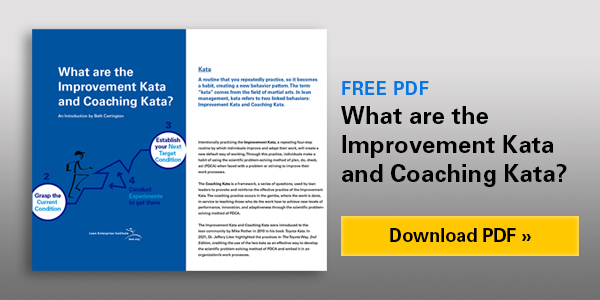Beth Carrington, LEI’s kata program director and instructor, describes the four routines practitioners use in the Improvement Kata and the five categories of questions asked in the Coaching Kata. Find a lightly edited transcript below.
Hello, I’m Beth Carrington. I’m the Improvement Kata and Coaching Kata instructor for Lean Enterprise Institute, and I’m here to explain a little bit about the Improvement Kata and Coaching Kata.
The Improvement Kata
The Improvement Kata is made up of four routines that a learner or a natural process owner would practice. The Improvement Kata is the practice routine, and a learner would practice these routines under the guidance of a sensei or coach.
First, you have to understand your direction: “What is my Challenge? What is my goal or objective?” Then, it’s a learning journey to achieve that challenge. So, the learner has to understand their challenge first.
Then they grasp their Current Condition as it relates to that Challenge, just enough so they can set a Target Condition somewhere between where they’re going. For example, let’s say the Challenge is a year out, but the Target Condition is just two weeks out. They’d ask: How do I predict my process needs to run two weeks out to get me a little bit closer to my annual challenge?
Once I have my Target Condition identified, I can then recognize obstacles that run PDCA – that’s the fourth routine, running the PDCA – I plan an experiment, do a coaching cycle, then if the coach releases me, I do the experiment: “PD.” Then, you check and compare what you expected to happen [in the experiment] to what actually happened. That’s the moment of learning. Then you “A,” act on that learning — [Some say adjust based on that learning].
The Coaching Kata
The Coaching Kata is a teaching routine. It’s a framework made up of a series of five categories of questions that [you, as a coach, asks the to] reinforce and evoke the desired scientific thought pattern that you’re looking for in your learner. And it simply starts with the question: “What is your Target Condition?” Next, the learner explains all of the conditions they expect to see in their hypothesis, “If I see this pattern of work with these process characteristics at this process metric level, then I predict I’ll get this improvement in my outcome metric.”
The second question is, “What is your Current Condition now?” The learner answers by comparing what their current condition is like versus their Target Condition, answering the question: “What’s my current pattern of work, my process characteristics, my process metric, and outcome metric?” The metrics are charted so you can see progress over time.
And then, the coach asks the most important question on the coaching card: “What did you learn?”
The coach will then flip the card over to talk about the last step the learner took, the step before the coaching cycle, and the coach will ask the learner, “What did you plan as your last step?” And then the coach asks, “What did you expect to happen and to learn from taking that step?” And the next question, “What actually happened?” [Throughout this interaction, the coach is listening to the learner’s observational skills and checking for facts and data.] And then, the coach asks the most important question on the coaching card: “What did you learn?” Then the learner talks about their learning and explains, “I found another obstacle, or I affirmed my hypothesis, so I’ve changed my Current Condition.”
The coach then flips the card over and asks, “What obstacles do you think are preventing you from reaching the Target Condition?” The fourth category of questions the coach asks is, “What is your next step against that obstacle? What is your next step?” And the learner describes the actions they’re going to take. The coach then asks, “What do you expect to happen and to learn from taking that step?” And the learner explains their expectations. And it’s those two together that explain an underlying hypothesis the learner has about overcoming an obstacle.
Finally, the coach asks, “How quickly can we go and see what we have learned from taking that step?” Hopefully, the answer is later today, or a typical response that a coach likes to hear is tomorrow, at tomorrow’s coaching cycle.
Learn More About Kata
Watch “A Video Primer on Improvement Kata as a Funnel,” in which Beth uses a visual model to explain the four routines of the Improvement Kata practice.
Improvement Kata/Coaching Kata
Develop Scientific Thinking, a Foundation of Lean Management in the 21st Century.








Hej Beth, thanks for the short video. Very useful as a “trailer” for my management team. Great to “hear” you again! Warmest greetings from me!
Hi Beth
Really good video and thanks for the PDF booklet .
Cheers
Paul
Paul
Glad to hear you enjoyed the video and booklet.
Beth